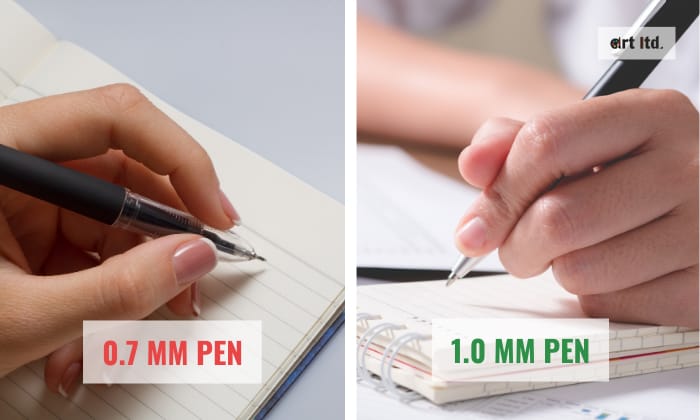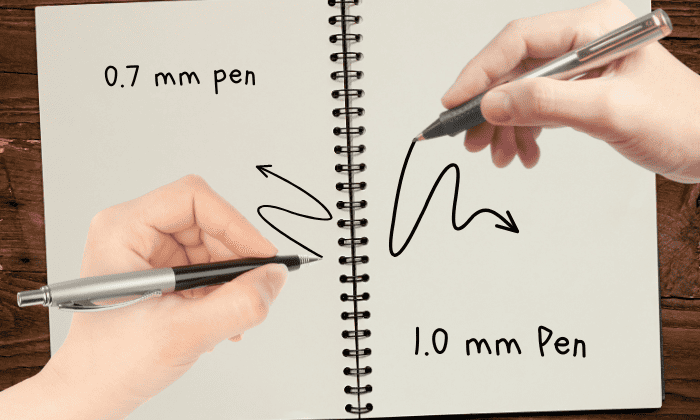Choosing the right pen is crucial, and one of the pivotal factors to consider is the tip size. Among various options available, 0.7 mm vs 1.0 mm pen tips are quite popular.
While a 1.0 mm pen offers bold strokes suitable for signatures or headings, a 0.7 mm pen shines in precision tasks such as technical drawing or fine writing.
This article will guide you through the 1.0 mm vs 0.7 mm pen comparison, including their advantages, disadvantages, and their ideal uses so you’d be able to pick one suitable for your needs.
Table of Contents
What is 1.0 and 0.7 Pen Point Sizes?
‘1.0 mm’ and ‘0.7 mm’ denote the diameter of the pen tip/ball in millimeters. The significance of this pen sizes mm lies in its direct impact on the thickness of the lines that a pen produces.
A 1.0 mm pen, due to its broader tip, naturally creates thicker strokes compared to the finer lines of a 0.7 mm pen. In terms of classification according to the size chart, the former falls into the medium-point pen size category, whereas the latter is considered a fine tip.
The nuances of these variances not only affect the visual appeal of the output but also play a considerable role in how the pen would be best utilized.
The Differences Between 1.0 mm vs 0.7 mm Pen
When it comes to the differences between 1.0 and 0.7 pen points, three core aspects come into play: line thickness, ink flow, and ideal usage scenarios.
A 1.0 mm pen, with its broader tip, dispenses more ink, leading to thicker lines. These pens are ideal for people who have average to large handwriting or those who frequently use alphabet-based languages. Although not as suitable for fine details like the smallest pen tips, it’s still ideal for drawing because it can quickly cover a large area.
However, you should be aware that this pen tip size can produce heavy ink flow, which may bleed through certain thin and particularly porous paper types. In addition, it’s not the best choice for writing logograms, such as Chinese, Japanese, or Korean.
A .7 pen, compared to a 1.0 pen, offers a more delicate line. This is a fine pen size that can serve a wide range of writing tasks, from note-taking to detailed sketching. They are also popular for those who have small or average-sized handwriting styles and users of logograms.
In terms of ink usage, a 0.7 mm pen will use less ink than its 1.0 mm counterpart, which means the former can last much longer.
Example for Each Pen Tip
In the 1.0 mm category, gel and ballpoint pens are the most common choices. A prominent 1.0mm gel pen is the Pilot G2 Premium, while a well-known 1.0mm ballpoint pen is the Uni-Ball Jetstream. They are great choices for artists who work with a variety of line widths or for those who want their signature to stand out.
For a 0.7 mm pen, the BIC Cristal Xtra Precision Ball Pen stands out with its fine point, delivering precise lines for detailed work. The Uni-ball Jetstream RT is another ideal 0.7 mm ballpoint pen that produces vibrant and quick-drying ink.
Which is Better?
There is no definitive ‘better’ size between 1.0 mm and 0.7 mm. Different types of pen tips have their own pros depending on personal style and needs.
If you prefer bolder, more noticeable lines and a smoother writing experience, then the 1.0 mm pen would be a better choice. This is particularly beneficial if you have larger handwriting or if you’re using the pen for artwork that requires thicker strokes.
In contrast, if your work requires precision and a finer look, then the 0.7 mm pen would be more suitable. This tip size also tends to last longer due to using less ink, which could be an important consideration if you’re using the pen heavily on a daily basis.
In a professional setting where documents may need to be scanned or photocopied, a 1.0 mm pen might stand out more. But for everyday note-taking, a 0.7 mm pen may be more practical.
Pros And Cons
1.0 mm pen
- Bold Lines: The standout feature of a 1.0 mm pen is the ability to create bold and striking lines that are easier to read, especially from a distance.
- Fast and Smooth Writing: Owing to the larger tip size, a 1.0 mm pen often provides a faster and smoother writing experience, gliding effortlessly on paper.
- Durability: The robust 1.0 mm pen point is generally more durable than its finer counterparts. It can withstand a heavier hand and more aggressive use without as much risk of damage.
- Less Precision: The flip side of creating bold lines is the lack of precision. If you’re working on detailed drawings or have small handwriting, a 1.0 pen tip might not satisfy you.
- Higher Ink Consumption: A 1.0 mm pen uses more ink per stroke. While this isn’t an issue for everyone, it might mean more frequent refills or replacements.
- Potential Bleed-Through: Some 1.0 mm pens may bleed through thin paper due to the higher ink output.
0.7 mm pen
- Precision: The first thing you’ll notice with a 0.7 mm pen is the precision it offers. It’s fantastic for detailed work or when your handwriting is quite small.
- Less Ink Consumption: A 0.7 mm pen uses less ink per stroke than a larger tip pen, like the 1.0 mm. Consequently, it might last longer, which is a bonus if you’re using an expensive pen.
- Paper Compatibility: Considering how a 0.7 mm pen dispenses less ink, it’s no surprise that it can be used on thin paper without bleeding through. In fact, you can even write on tissue paper with this pen.
- Delicate Tip: Because the tip is more slender, it can be more prone to damage, especially under heavy-handed use.
- Ink Flow Issues: Sometimes, especially with cheaper models, a 0.7 mm pen might have inconsistent ink flow. You might find yourself retracting your lines and letters.
- Harder To Read: As the lines a 0.7 mm pen produces can be quite thin, some people may find them harder to read, especially from afar.
Conclusion
When comparing the 0.7 mm vs 1.0 mm pen, each has unique advantages. The 0.7 mm pen, with its finer tip, offers a high level of precision, making it an excellent choice for individuals with smaller handwriting or tasks requiring more detail.
The 1.0 mm pen, conversely, providing a bolder and more prominent line, is ideal for larger handwriting and applications where visibility is paramount.
Hopefully, this 1.0 vs 0.7 mm comparison has helped you determine what pen best suits you. Let us know which one you’d pick for your daily use.

Art has always been a part of my life; it influences my upbringing and later my career choice. For me, it is always a part of my parenting technique. So for whichever purpose that you come to art, you can start here with us.




